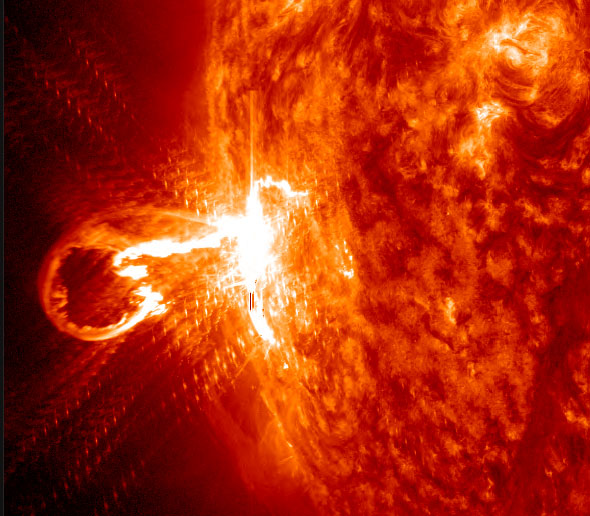Create a free profile to get unlimited access to exclusive videos, sweepstakes, and more!
Boom! The Sun Blurts Out an X-Class Flare!

Remember that ginormous sunspot that was seen in January and was so huge and strong it actually survived long enough to be brought back around the far side of the Sun and face us again in early February?
Incredibly, it’s still there! And it just announced its return by literally exploding, blasting out a very respectable X-class flare. It started at about 00:30 UTC on Tuesday morning (7:30 p.m. Eastern time), and was still ongoing when I wrote this post (at 01:30 UTC).
The image at the top of this post is from the Solar Dynamic Observatory, taken in the ultraviolet where flares are very obvious. As I’ve described on the blog before, solar flares are where the huge magnetic energies stored in sunspots get let loose all at once, creating an explosion that dwarfs all of humanity’s weapons combined. This flare was accompanied by a spectacular eruptive prominence as well, a towering plume of solar plasma bursting out into space:
Gorgeous. But terrifying to think of the energy being violently released! I’m glad it’s 150 million kilometers away, and facing away from us. The classification of the flare is X 4.9, because that’s where it peaked on the detectors on the GOES satellite's X-ray detectors:
That plot shows the X-ray emission (technically the flux, the amount detected) over time, and the flare is pretty obvious. The plot tick marks are logarithmic, but the flare class is linear, so the first line going into the X range is X1, then X2, which is twice as bright as X1, then X3, which is three times as bright as X1, and so on. The flare is currently fading. Last month this spot blew out an X1 flare; this one was nearly five times as powerful.
But this sunspot is coming back around now. Over the next week the Sun’s rotation will bring it back to the center of the Sun’s disk, before once again sweeping it around to the Sun’s far side. We’ll have to keep our eyes on this one. A big flare can block radio transmissions, damage satellites, hurt astronauts in orbit, and (on the plus side) create dramatic aurorae. Let’s hope for the latter, but not the three former!
Stay tuned to Spaceweather.com for more info.
Correction, Feb. 25 at 16:30 UTC: I originally mislabled the red line in the caption of the graph, saying it was from higher-energy X-rays. My apologes; it's been corrected.














